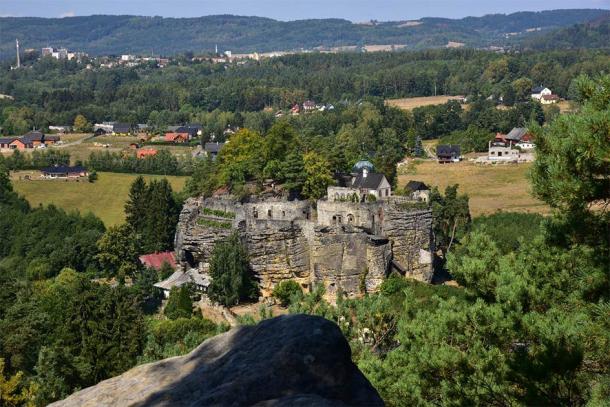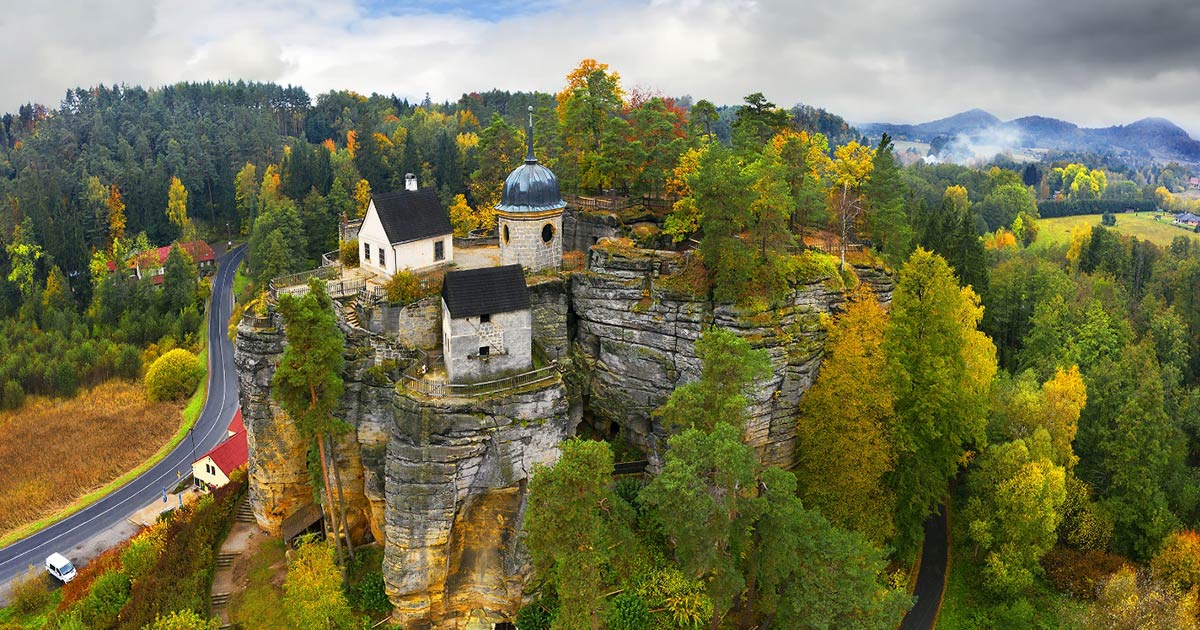Sloup Castle: Bohemia’s Salt Trade Defense, Hermitage and Tourist Spot
Sloup Castle is a rock castle located in the northern part of what is today the Czech Republic. The castle dates all the way back to the 14th century AD, when the area it is in was part of the Kingdom of Bohemia. Due to its strategic position, Sloup Castle was a formidable stronghold. Nevertheless, the castle did not serve this defensive function throughout its history, having undergone several transformations. Most recently, Sloup Castle was acquired by the House of Kinský, who turned the landmark into a tourist attraction.
The Historical Origins Of Sloup Castle
Sloup Castle is situated in the town of Sloup v Čechách (meaning “Sloup in Bohemia”), in Liberec, the northernmost part of the historical region of Bohemia. The castle lies about 117.5 km (73 mi) from Prague, the Czech capital. Sloup Castle sits on top of a 33 m (108 ft) high sandstone rock column, providing its long-dead occupants with a commanding view of the surrounding alluvial valley. Incidentally, the word “sloup” means “column” in Czech, an apt description of the outcrop on which the castle stands.

Another view of Sloup Castle in Bohemia. (Radko / Adobe Stock)
Although Sloup Castle was founded during the Middle Ages, the rocky outcrop on which it was built was already occupied during the prehistoric period. The archaeological evidence from the site includes artifacts from the Globular Amphora culture, dating to the 3 rd millennium BC, the Únětice culture, the Lusatian culture, the Celts, and an ancient Germanic culture known as the Podmokelská culture.
It has been cautioned, however, that these cultures are only represented at the site by isolated artifacts. In other words, this does not necessarily mean that the outcrop was continuously occupied over the millennia. Nevertheless, considering the site’s strategic location, it is not difficult to see why it was such an attractive spot for the various groups that lived in the area over the ages.
It has been suggested that a permanent settlement was established on the top of the outcrop as early as the 7 th century AD, following the arrival of the Slavs in the region. The evidence cited to support this is the jug-shaped grain storage facility that was discovered at the site. The storage facility is 7 m (23 ft) deep and can be accessed today via one of its sides. Since the storage of supplies is an indication of a permanent settlement, it has been argued that such a settlement had already been established at the site prior to the Middle Ages. Nevertheless, this argument is still a weak one, as there is no further evidence, at present, to support it.
The first mentioning of Sloup Castle in the historical records dates to the first half of the 14 th century AD. During this period, Sloup was under the rule of the House of Ronovec, who established the castle in order to control the salt trade that passed through their territory.

The coat of arms of the House of Ronovec, who built Sloup Castle to protect their lucrative salt trading route. (Luzicke Hory blog)
In the following century, northern Bohemia was embroiled in the Hussite Wars, a conflict between the Hussites (a proto-Protestant Christian movement) and the Catholics. At the beginning of the war, the conflict had not reached Sloup Castle region. In 1426, however, the Hussites launched a military campaign into northern Bohemia. Although some towns were taken, and others burnt down, it seems that the Hussites never reached Sloup Castle.
- The Fascinating History of Medieval Castles: From Emergence to Obsoletion
- Bronze Age Sword Found at Secret New Site in Czech Republic
- The Knights of Blanik Mountain Are Ready to Face the Darkest Hour
In 1440 AD The Castle Becomes A Knight’s Seat Of Power
Apart from that, not much information about Sloup Castle between the 14 th century and the end of the Hussite Wars has been preserved. Instead, the next appearance of Sloup Castle in the historical records is in the 1440s AD, around a decade after the end of the Hussite Wars. In 1440, the castle came under the control of Mikeš Pancír of Smojno, a knight who had distinguished himself during the Hussite Wars. On the one hand, he would provide information about the Hussites to the Lusatian League (an alliance of six towns in the Bohemian region of Upper Lusatia). On the other, he would carry out raids on the Lusatians. The conflict between Mikeš and the Lusatians continued after the end of the Hussite Wars.

Sloup Castle, located in northern Bohemia, just south of Zittau on this map, figured in the Hussite Wars, which lasted from 1419 to 1434 AD. (Cameron Pauley / CC BY-SA 4.0)
In 1444 AD, the Lusatians launched an attack on Sloup Castle. Although they managed to inflict considerable damage on Mikeš’ estates, the Lusatians failed to take the castle. In the following year, the Lusatians were back at Sloup, and besieged the castle for five weeks. The Lusatians once again failed to take the castle by force, but ultimately, the defenders surrendered when their supplies ran out. The castle was damaged during the siege but was repaired soon after the peace between Mikeš and the Lusatians was concluded. Nevertheless, Sloup Castle was soon abandoned, as it was no longer comfortable enough for habitation.

The interior of the Sloup v Cechach Hermitage at Sloup Castle. (jindrich / Adobe Stock)
Sloup Castle: Sacked By The Swedes And Change Of Ownership
During the 16 th and 17 th centuries, the ownership of Sloup Castle changed hands several times. For most of the two centuries, Sloup Castle enjoyed a peaceful existence. In 1639, however, the castle was burned down by the Swedes, who were marching through Bohemia. This was one of the more significant events in the castle’s history during that period.
After its sacking, Sloup Castle was left to fall into ruins. The castle, however, was soon transformed into a sacred site, as it was donated to hermits. These hermits lived amongst the ruins of the castle until the second half of the 18 th century, when they were ordered by Joseph II, the Holy Roman Emperor, to leave. The remains of the Sloup v Cechach Hermitage, a tall tower, still stand on the top of the rock column.

The coat of arms of House of Kinsky: 3 wolf teeth curved towards the top point of the shield. (See page for author / CC BY-SA 3.0)
Although the hermits were occupying the ruins of Sloup Castle, the property was actually owned by the House of Kinský. This is an ancient Czech noble family whose roots stretch all the way back to the 13 th century AD. Although the family lost power during the early 17 th century AD, they regained it by the end of that same century. In the early 18 th century AD, they came into possession of Sloup Castle. It was this family, who, after the hermits were ordered to leave, decided to turn the castle into a tourist attraction.

A painted solar clock embedded in the stone walls of Sloup Castle, created by the hermit Václav Rincholin. (Matěj Baťha / CC BY-SA 2.5)
The Ruins Of Sloup Castle: A Tourist Attraction Today
Although Sloup Castle is still referred to as a castle, its official website acknowledges that this is in fact a “catchphrase,” and one that is used mostly by tourists. Nevertheless, it is a very useful name, since most locals living in the surrounding area recognize it.
In reality, however, little has been done to restore the castle to its former glory, and hence it would be more appropriate to describe it as “ruins.” Although the castle is now empty, its external structures have been maintained for tourists to see.
Other features of the castle that are recommended to tourists include its top platform, which offers visitors a panoramic view of the surrounding landscape, a church from 1693 (or what’s left of it), and a sundial created by the hermit Václav Rincholin. A variety of public and private cultural events, such as summer concerts, temporary art exhibitions, and fencing performances, are also held on the grounds of Sloup Castle.
Top image: Sloup Castle and the Sloup v Cechach hermitage. Source: Pecold / Adobe Stock
By Wu Mingren
References
Visit Czech Republic, 2020. Sloup Castle. [Online]
Available at: https://www.visitczechrepublic.com/en-US/5873ede8-1d2e-4390-abdc-3b3e5ea...
www.amazingczechia.com, 2020. Sloup Castle. [Online]
Available at: https://www.amazingczechia.com/sights/sloup-castle/
www.cesky-raj.info, 2020. Ruined castle and Hermitage Sloup. [Online]
Available at: https://www.cesky-raj.info/dr-en/1339-ruined-castle-and-hermitage-sloup....
www.digital-guide.cz, 2009. The Kinsky dynasty. [Online]
Available at: http://www.digital-guide.cz/en/realie/aristocracy/the-kinsky-dynasty/
www.hradsloup.cz, 2020. The Rock Castle Sloup. [Online]
Available at: http://www.hradsloup.cz/en/home/



















